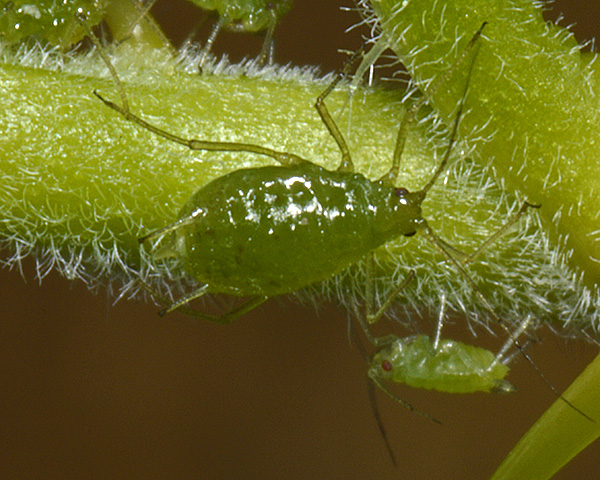The big picture: using wildflower strips for pest control
Aphids attacking lettuce fields in England are showing surprising regional patterns that could complicate efforts to protect one of the country’s most important salad crops, new research has revealed.
The currant-lettuce aphid, Nasonovia ribisnigri is a destructive pest that feeds on outdoor lettuces. The new analysis, using data from the Rothamsted based National Insect Survey, with partners from the University of Warwick's Crop Centre, found that populations in England are divided sharply between the east and west of the country. The finding, based on nearly two decades of genetic sampling, suggests that the pest’s movements are strongly tied to lettuce-growing regions and may not spread as widely as previously thought.
The clear geographic divide we see has major implications for how we monitor and control this pest
The study, which analysed insects collected from ten sites between 2003 and 2020, showed that while aphids migrate from the west into eastern lettuce fields, they rarely move in the opposite direction. Researchers say the pattern could be linked to the insect’s relationship with its winter host, blackcurrant and related Ribes plants, and its summer host, lettuce.

The findings come at a critical time for growers. Traditional defences against the pest, such as resistant lettuce varieties, have started to fail in recent years, leaving few effective alternative options for control. Despite this, populations of N. ribisnigri appear to have remained relatively stable, even as warmer temperatures and shifting weather patterns create more favourable conditions for the aphid.
Dr Dion Garrett, who led the study, also found that the insects are highly inbred and mostly reproduce in cycles tied to the seasons, a factor that may help explain their long-term persistence.
With the UK lettuce industry worth hundreds of millions of pounds annually, the work highlights the urgent need to rethink pest management strategies. “The clear geographic divide we see has major implications for how we monitor and control N. ribisnigri,” said Dr Garrett, warning that growers will need region-specific approaches to tackle the pest in future.
Main image: Shutterstock

MOLECULAR ENTOMOLOGIST
Rothamsted Research is the longest-running agricultural research institute in the world. We work from gene to field with a proud history of ground-breaking
discoveries in areas as diverse as crop management, statistical interpretation and soil health. Our founders, in 1843, were the pioneers of modern
agriculture, and we are known for our imaginative science and our collaborative approach to developing innovative farm practice.
Through independent research, we make significant contributions to improving agri-food systems in the UK and internationally, with
economic impact estimated to exceed £3 bn in annual contribution to the UK economy. Our strength lies in our systems approach, which combines strategic research,
interdisciplinary teams and multiple partnerships.
Rothamsted is home to three unique National Bioscience Research Infrastructures which are open to researchers from all over the world:
The Long-Term Experiments,
Rothamsted Insect Survey and the
North Wyke Farm Platform.
We are strategically funded by the Biotechnology and Biological Sciences Research Council (BBSRC), with additional support from other national and
international funding streams, and from industry. We are also supported by the Lawes Agricultural Trust (LAT).
The Biotechnology and Biological Sciences Research Council is part of UK Research and Innovation, a non-departmental public body funded by a grant-in-aid
from the UK government.
BBSRC invests to push back the frontiers of biology and deliver a healthy, prosperous and sustainable future. Through our investments, we build and support a vibrant,
dynamic and inclusive community which delivers ground-breaking discoveries and develops bio-based solutions that contribute to tackling global challenges,
such as sustainable food production, climate change, and healthy ageing.
As part of UK Research and Innovation (UKRI), we not only play a pivotal role in fostering connections that enable the UK’s world-class research and innovation system
to flourish – we also have a responsibility to enable the creation of a research culture that is diverse, resilient, and engaged.
BBSRC proudly forges interdisciplinary collaborations where excellent bioscience has a fundamental role. We pioneer approaches that enhance the equality, diversity,
and inclusion of talent by investing in people, infrastructure, technologies, and partnerships on a global scale.
The Lawes Agricultural Trust, established in 1889 by Sir John Bennet Lawes, supports Rothamsted Research’s national and international agricultural science through the provision of land, facilities and funding. LAT, a charitable trust, owns the estates at Harpenden and Broom's Barn, including many of the buildings used by Rothamsted Research. LAT provides an annual research grant to the Director, accommodation for nearly 200 people, and support for fellowships for young scientists from developing countries. LAT also makes capital grants to help modernise facilities at Rothamsted, or invests in new buildings.